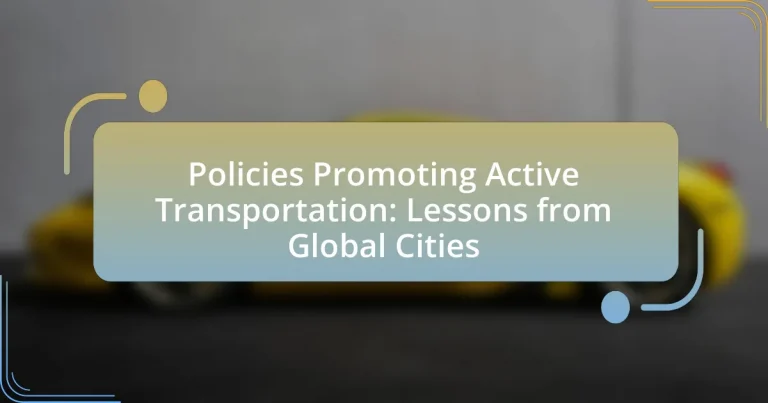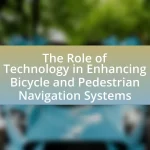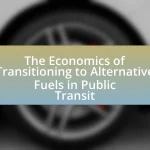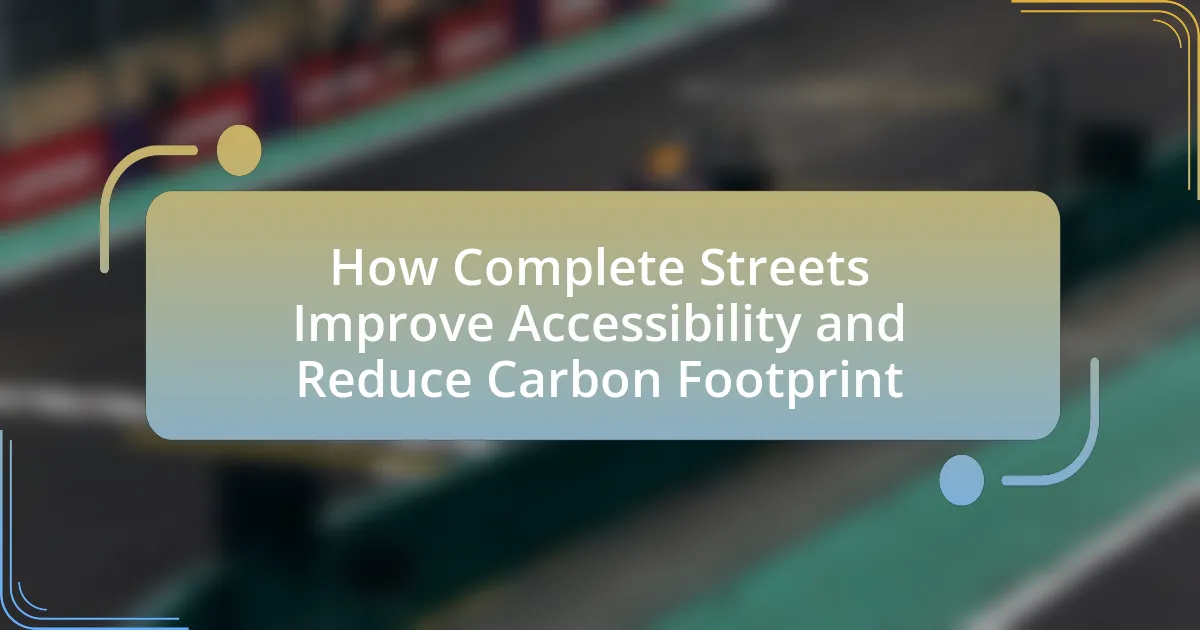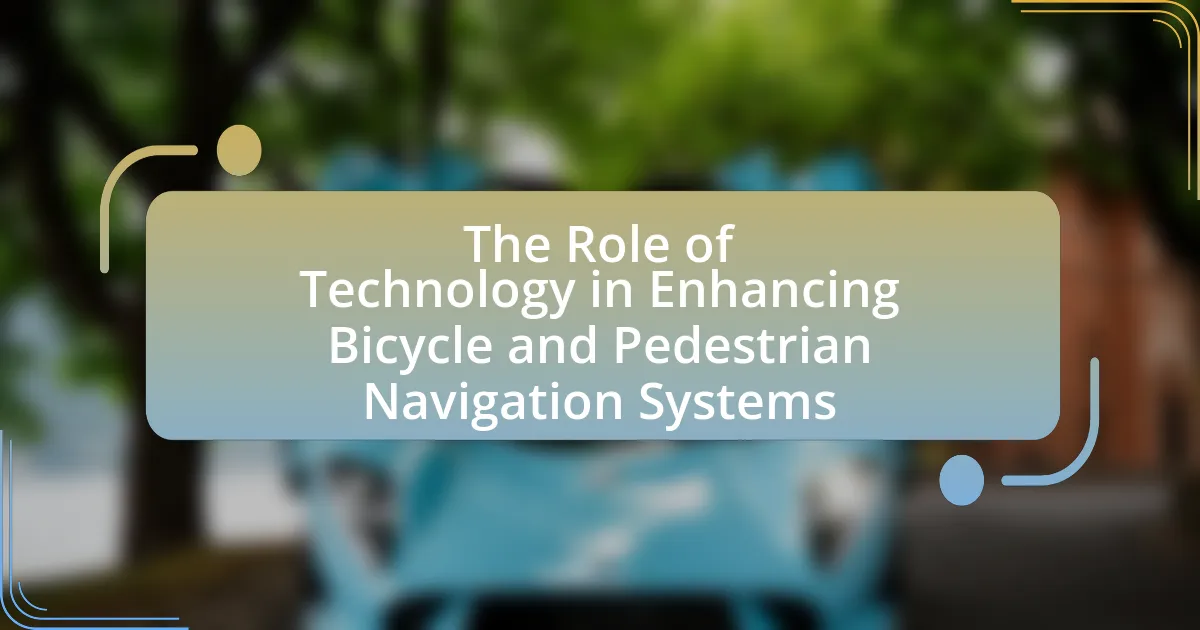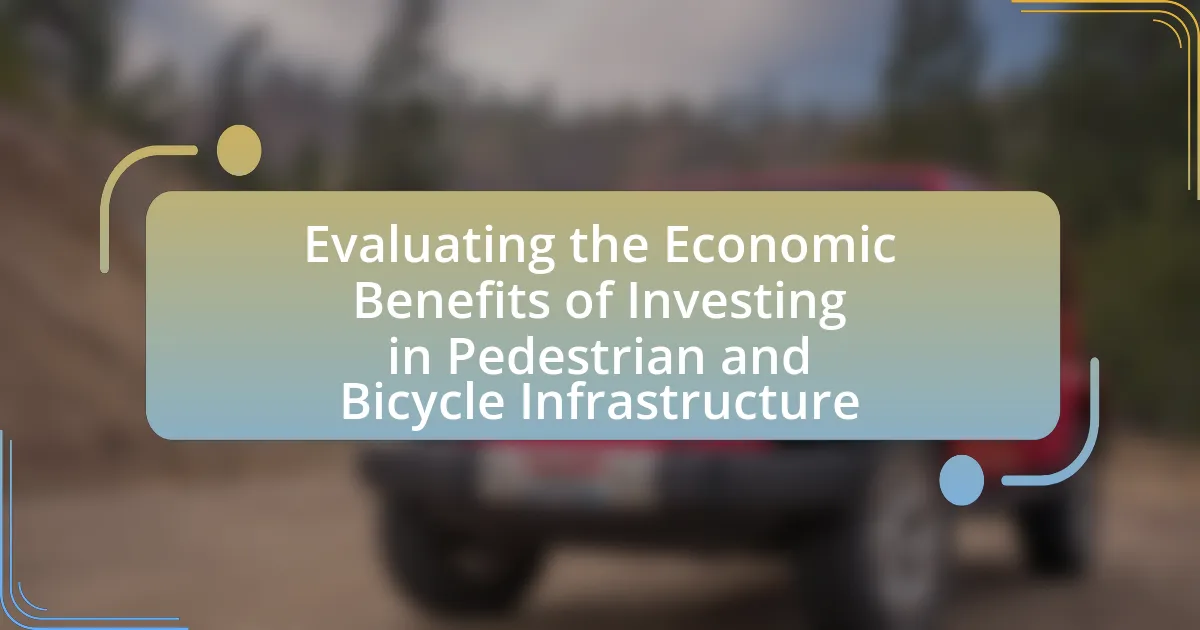Policies promoting active transportation are strategic initiatives aimed at encouraging walking, cycling, and public transit use as primary transportation modes. The article examines how these policies vary across global cities, highlighting successful examples from Copenhagen and Amsterdam, which have invested heavily in cycling infrastructure and pedestrian-friendly designs. It discusses the factors influencing the effectiveness of these policies, including infrastructure quality, cultural attitudes, and community engagement, while also addressing the importance of active transportation for urban development, traffic congestion reduction, and public health improvement. Additionally, the article outlines best practices for implementing such policies and the challenges cities face in promoting active transportation.

What are Policies Promoting Active Transportation?
Policies promoting active transportation are strategies and regulations designed to encourage walking, cycling, and the use of public transit as primary modes of transport. These policies often include infrastructure investments, such as bike lanes and pedestrian pathways, as well as incentives like subsidies for public transit use and educational campaigns about the benefits of active transportation. Evidence from cities like Copenhagen and Amsterdam shows that such policies can significantly increase the share of trips made by walking and cycling, leading to reduced traffic congestion and improved public health outcomes.
How do these policies differ across global cities?
Policies promoting active transportation differ significantly across global cities due to variations in urban design, cultural attitudes, and government priorities. For instance, cities like Copenhagen prioritize cycling infrastructure, investing over 400 million euros in bike lanes and facilities, resulting in over 62% of residents commuting by bike. In contrast, cities such as Los Angeles focus more on expanding public transit systems, with a $120 billion investment plan aimed at reducing car dependency. Additionally, cities like Amsterdam integrate pedestrian-friendly policies, with 30% of urban space dedicated to walking paths, reflecting a cultural emphasis on pedestrian mobility. These differences illustrate how local contexts shape the effectiveness and implementation of active transportation policies.
What factors influence the effectiveness of these policies?
The effectiveness of policies promoting active transportation is influenced by several key factors, including infrastructure quality, public awareness, and community engagement. High-quality infrastructure, such as dedicated bike lanes and pedestrian pathways, directly impacts the safety and convenience of active transportation options, leading to increased usage. Public awareness campaigns educate citizens about the benefits of active transportation, which can shift cultural attitudes and encourage more people to adopt these modes of travel. Additionally, community engagement ensures that policies reflect the needs and preferences of local populations, fostering greater acceptance and participation. Research indicates that cities with comprehensive active transportation policies, such as Copenhagen and Amsterdam, have seen significant increases in cycling and walking rates, demonstrating the importance of these factors in policy effectiveness.
How do cultural attitudes impact policy implementation?
Cultural attitudes significantly impact policy implementation by shaping public perception and acceptance of policies. For instance, in cities where cycling is viewed positively as a sustainable mode of transport, policies promoting cycling infrastructure tend to receive greater support and compliance from the community. Research conducted in Copenhagen shows that cultural acceptance of cycling has led to the successful implementation of extensive bike lanes, resulting in over 60% of residents using bicycles for daily commutes. Conversely, in cities where car culture prevails, policies aimed at reducing car usage often face resistance, leading to ineffective implementation. This demonstrates that cultural attitudes directly influence the effectiveness and acceptance of transportation policies.
Why are these policies important for urban development?
Policies promoting active transportation are crucial for urban development because they enhance mobility, reduce traffic congestion, and improve public health. By prioritizing walking, cycling, and public transit, these policies create more accessible and sustainable urban environments. For instance, cities that have implemented such policies, like Copenhagen and Amsterdam, have seen significant increases in cycling rates, leading to reduced greenhouse gas emissions and improved air quality. Additionally, studies show that active transportation policies can lead to a 30% decrease in traffic-related injuries, demonstrating their effectiveness in promoting safer urban spaces.
What role do they play in reducing traffic congestion?
Policies promoting active transportation, such as cycling and walking initiatives, play a significant role in reducing traffic congestion by encouraging a shift from motor vehicle use to more sustainable modes of transport. This shift decreases the number of cars on the road, leading to lower traffic volumes. For instance, cities that have implemented bike-sharing programs and expanded pedestrian pathways have reported reductions in vehicle trips by up to 30%, as seen in studies from cities like Copenhagen and Amsterdam. These policies not only alleviate congestion but also enhance urban mobility and improve air quality, demonstrating their effectiveness in managing traffic flow.
How do they contribute to public health and well-being?
Policies promoting active transportation contribute to public health and well-being by increasing physical activity levels among populations. Research indicates that cities implementing such policies, like improved cycling infrastructure and pedestrian-friendly urban designs, lead to higher rates of walking and cycling. For instance, a study published in the American Journal of Public Health found that cities with dedicated bike lanes saw a 50% increase in cycling rates, which correlates with reduced obesity rates and lower incidences of chronic diseases. Additionally, active transportation reduces air pollution and traffic-related injuries, further enhancing community health outcomes.

What lessons can be learned from global cities?
Global cities demonstrate that effective policies promoting active transportation can significantly enhance urban mobility and public health. For instance, cities like Copenhagen and Amsterdam have successfully implemented extensive cycling infrastructure, resulting in over 60% of residents commuting by bike, which reduces traffic congestion and lowers carbon emissions. Additionally, these cities prioritize pedestrian-friendly urban design, leading to increased foot traffic in commercial areas and improved local economies. The integration of public transportation with active modes, as seen in cities like Barcelona, further illustrates the importance of cohesive transport policies that encourage walking and cycling. These examples underscore the necessity of comprehensive planning and investment in infrastructure to foster sustainable urban environments.
Which cities are leading examples of successful active transportation policies?
Copenhagen and Amsterdam are leading examples of successful active transportation policies. Copenhagen has implemented extensive cycling infrastructure, resulting in over 62% of its residents commuting by bike daily, supported by a network of dedicated bike lanes and bike-sharing programs. Amsterdam similarly prioritizes cycling, with around 60% of trips made by bike, facilitated by its flat terrain and comprehensive cycling routes. Both cities have demonstrated that investment in active transportation not only reduces traffic congestion but also improves public health and environmental sustainability.
What specific strategies have been implemented in these cities?
Cities have implemented various specific strategies to promote active transportation, including the development of extensive cycling infrastructure, pedestrian-friendly urban designs, and integrated public transit systems. For instance, Copenhagen has invested in over 390 kilometers of dedicated bike lanes, significantly increasing cycling rates and reducing car dependency. Similarly, Amsterdam has prioritized pedestrian zones and traffic calming measures, resulting in a 60% increase in walking and cycling trips over the past two decades. Additionally, cities like Barcelona have introduced superblocks, which restrict vehicle access in certain areas to enhance walkability and reduce pollution. These strategies collectively demonstrate a commitment to fostering environments conducive to active transportation, supported by data showing increased usage and improved public health outcomes.
How have these strategies evolved over time?
Policies promoting active transportation have evolved from basic infrastructure development to comprehensive, multi-faceted approaches that integrate health, environmental, and social equity considerations. Initially, cities focused on building bike lanes and sidewalks to encourage walking and cycling. Over time, these strategies have expanded to include public awareness campaigns, incentives for using active transportation, and policies aimed at reducing car dependency. For instance, cities like Copenhagen and Amsterdam have implemented extensive cycling networks and urban planning that prioritizes pedestrians and cyclists, demonstrating a shift towards sustainable urban mobility. This evolution reflects a growing recognition of the benefits of active transportation for public health, environmental sustainability, and urban livability, supported by research indicating that increased active transportation leads to lower rates of obesity and improved air quality.
What challenges have these cities faced in promoting active transportation?
Cities promoting active transportation have faced challenges such as inadequate infrastructure, safety concerns, and cultural resistance. Inadequate infrastructure includes a lack of dedicated bike lanes and pedestrian pathways, which discourages people from choosing walking or cycling. Safety concerns arise from high traffic volumes and speeds, leading to accidents that deter potential users. Cultural resistance often stems from a reliance on cars, where communities may prioritize vehicle access over pedestrian and cyclist needs, making it difficult to shift public perception and behavior towards active transportation. These challenges are documented in various studies, highlighting the need for comprehensive planning and community engagement to effectively promote active transportation.
How have they addressed resistance from stakeholders?
They have addressed resistance from stakeholders by engaging in comprehensive stakeholder consultations and incorporating feedback into policy design. For instance, cities like Copenhagen and Amsterdam have successfully involved local communities and businesses in the planning process, ensuring that their concerns are heard and addressed. This participatory approach has led to increased buy-in and support for active transportation initiatives, as evidenced by the significant rise in cycling rates and public support for related policies in these cities.
What funding mechanisms have been utilized to support these initiatives?
Funding mechanisms utilized to support initiatives promoting active transportation include government grants, public-private partnerships, and dedicated transportation funds. Government grants often come from federal or state sources aimed at enhancing infrastructure for walking and cycling, such as the Transportation Alternatives Program in the United States, which allocated over $800 million in 2020 for such projects. Public-private partnerships leverage investments from private entities to develop and maintain active transportation infrastructure, exemplified by various bike-sharing programs globally. Additionally, dedicated transportation funds, like those established in cities such as Amsterdam, ensure a continuous revenue stream specifically earmarked for active transportation projects, enhancing their sustainability and effectiveness.
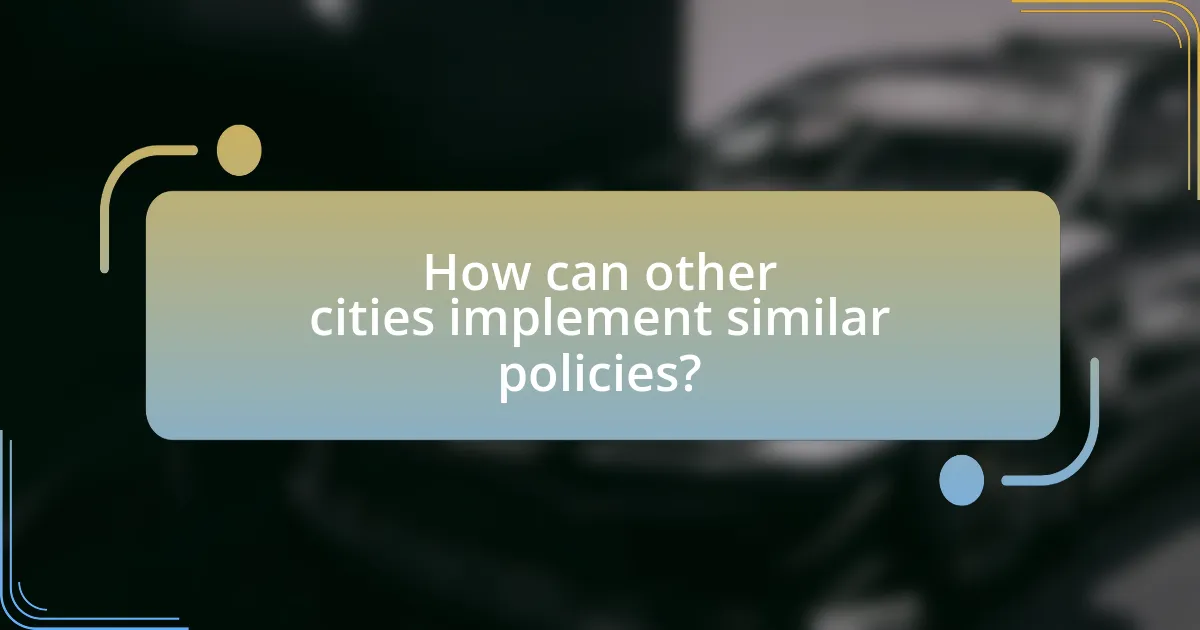
How can other cities implement similar policies?
Other cities can implement similar policies by adopting comprehensive active transportation plans that prioritize walking, cycling, and public transit. These plans should include infrastructure investments such as dedicated bike lanes, pedestrian-friendly streets, and improved public transport systems. For instance, cities like Copenhagen and Amsterdam have successfully integrated cycling into their urban planning, resulting in over 60% of residents commuting by bike. Additionally, cities should engage in community outreach to gather public input and foster support for these initiatives, as seen in Portland, where community involvement led to the successful implementation of the city’s bike share program. By analyzing successful case studies and tailoring strategies to local contexts, cities can effectively promote active transportation.
What best practices should be considered when developing active transportation policies?
Best practices for developing active transportation policies include comprehensive stakeholder engagement, data-driven decision-making, and the integration of land use and transportation planning. Engaging stakeholders, such as community members and local organizations, ensures that policies reflect the needs and preferences of the population, which has been shown to increase public support and usage of active transportation options. Data-driven decision-making involves collecting and analyzing data on current transportation patterns, safety concerns, and demographic trends to inform policy development, as evidenced by cities like Copenhagen, which utilized extensive cycling data to enhance their bike infrastructure. Lastly, integrating land use and transportation planning promotes accessibility and connectivity, as seen in cities like Portland, where mixed-use developments encourage walking and cycling by reducing distances between destinations.
How can community engagement enhance policy effectiveness?
Community engagement enhances policy effectiveness by ensuring that policies are tailored to the actual needs and preferences of the population they serve. When communities actively participate in the policy-making process, they provide valuable insights and feedback that can lead to more relevant and practical solutions. For instance, a study by the National Academy of Sciences found that community involvement in transportation planning resulted in projects that better met local needs and increased public support, ultimately leading to higher usage rates of active transportation options. This demonstrates that policies developed with community input are more likely to be accepted and utilized, thereby improving their overall effectiveness.
What metrics should be used to evaluate policy success?
To evaluate policy success in promoting active transportation, metrics such as mode share, user satisfaction, safety statistics, and health outcomes should be utilized. Mode share measures the percentage of trips made by walking, cycling, or public transit, indicating the effectiveness of policies in shifting transportation habits. User satisfaction surveys provide insights into public perception and acceptance of active transportation initiatives. Safety statistics, including accident rates and injuries, assess the impact of policies on public safety. Health outcomes, such as changes in physical activity levels and related health metrics, demonstrate the broader benefits of active transportation policies. These metrics collectively provide a comprehensive view of policy effectiveness in fostering active transportation.
What common pitfalls should cities avoid when promoting active transportation?
Cities should avoid the pitfall of inadequate infrastructure when promoting active transportation. Insufficient bike lanes, poorly maintained sidewalks, and a lack of safe crossings can deter individuals from choosing walking or cycling as viable options. Research indicates that cities with dedicated cycling infrastructure see a significant increase in cycling rates; for instance, Copenhagen’s investment in bike lanes has led to over 60% of its residents commuting by bicycle. Additionally, cities must not overlook community engagement; failing to involve residents in planning can result in solutions that do not meet their needs, as seen in various urban areas where top-down approaches led to underutilized facilities. Lastly, neglecting to address safety concerns can undermine efforts; cities that do not implement measures to reduce traffic speeds or enhance visibility at intersections may see higher accident rates, discouraging active transportation.
How can cities ensure equitable access to active transportation options?
Cities can ensure equitable access to active transportation options by implementing inclusive planning processes that prioritize underserved communities. This involves conducting thorough assessments of transportation needs, ensuring infrastructure investments in low-income areas, and providing affordable access to bicycles and public transit. For instance, cities like Bogotá have successfully integrated bike-sharing programs that are subsidized for low-income residents, resulting in increased usage among marginalized populations. Additionally, policies that promote safe walking and cycling routes, such as protected bike lanes and pedestrian-friendly streets, have been shown to enhance accessibility and safety, thereby encouraging active transportation among all demographics.
What role does infrastructure play in the success of these policies?
Infrastructure is crucial for the success of policies promoting active transportation, as it provides the necessary physical framework for safe and efficient movement. Well-designed infrastructure, such as dedicated bike lanes, pedestrian pathways, and public transit systems, encourages higher rates of walking and cycling by ensuring safety and accessibility. For instance, cities like Copenhagen and Amsterdam have seen significant increases in cycling rates due to investments in comprehensive cycling infrastructure, which has led to a 62% and 38% increase in cycling, respectively, over the past decade. This demonstrates that effective infrastructure directly correlates with the success of active transportation policies by facilitating user adoption and promoting sustainable mobility.
What practical steps can cities take to encourage active transportation?
Cities can encourage active transportation by implementing dedicated bike lanes, improving pedestrian infrastructure, and enhancing public transit accessibility. Dedicated bike lanes, which separate cyclists from motor vehicle traffic, have been shown to increase cycling rates; for instance, cities like Copenhagen have seen a 62% increase in cycling after such infrastructure was developed. Improving pedestrian infrastructure, such as wider sidewalks and safe crossings, promotes walking; studies indicate that walkable neighborhoods can increase walking rates by up to 50%. Additionally, enhancing public transit accessibility, including integrating bike-sharing programs and ensuring transit stops are within walking distance, can further support active transportation. These steps collectively create a safer and more inviting environment for walking and cycling, leading to increased usage of these modes of transport.
